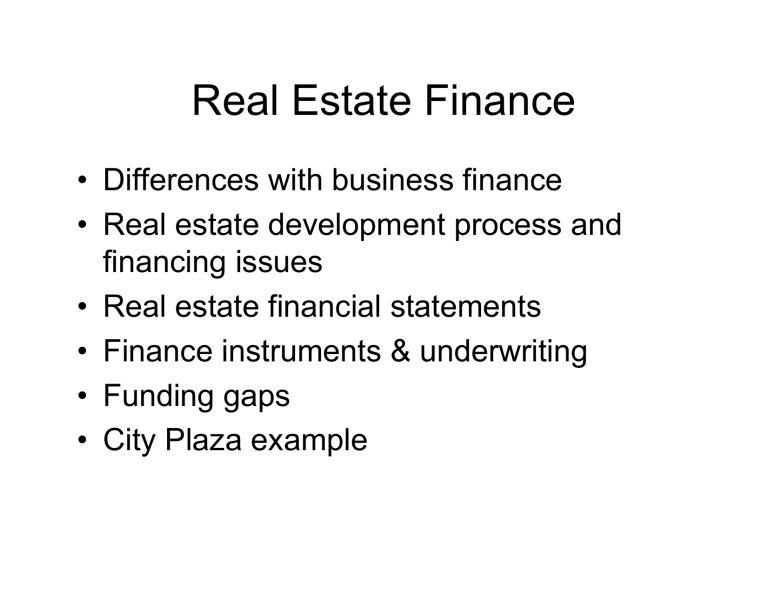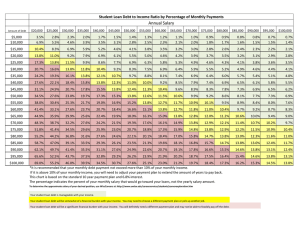Real Estate Finance

Real Estate Finance
• Differences with business finance
• Real estate development process and financing issues
• Real estate financial statements
• Finance instruments & underwriting
• Funding gaps
• City Plaza example
Differences with business finance
• Scale of investment is large
• Financing physical, fixed assets
• Need for long-term financing
• Use of separate construction and permanent financing
• Competition and markets are regional and/or local
• More predictable income & expenses
Three Phases of Development
• Predevelopment
– Planning & design, site control, permitting, preleasing/sales, securing financing
– Large costs, high risk no revenue=>requires equity, grants, deferred loans
• Construction & development
– Site acquisition, final design & contractor selection, construction
– Limited risk => construction loan and equity
• Occupancy and management
– Asset management=> permanent debt take-out
– Retire debt, realize equity returns
Real Estate Financial Statements
Development Budget
• Sources and uses of funds statement
• Analogous to a balance sheet
– Acquisition, hard costs, and soft costs
– Contingencies and reserves
– Per square foot basis useful for comparisons
• Sources of funds
– Debt sources, equity investments, grants
Real Estate Financial Statements
Operating Pro Forms
• Revenue, expenses and net cash flow
• CAM, escalators, and percentage rent
– Lease terms define revenue –key to analyze
• Vacancy rates
• Operating expenses
– IREM, ULI comparable project data to analyze
– Replacement and operating reserves
• Cash flow, debt service and net cash flow
• Supportable debt: PV of [cash flow/DSCR]
• Supportable equity: PV of net cash flow & expected gain on sale
Real Estate Debt Instruments
• Predevelopment loan
• Construction loan
• Real estate mortgage
• Mini-perm loan
• Bridge loan
Underwriting Real estate Loans
• Development Team Capacity
– Experience & ability of development team members
– Management company deserves special attention
• Project cash flow risk
– Initial lease-up risk: will property be occupied at target rent?
– Tenant credit risk: will tenants pay their rent?
– Re-leasing/market risk
– Operating expense risk: are operating costs adequate ?
• Collateral value and appraisals
– Appraisals set the market value & max. Three ways to value a property: cost, comparable sales, discounted cash flow.
– Quality of construction
– Quality of maintenance and replacement funding
Common Funding Gaps
• Supply of pre-development and equity financing
• Weak markets:
– Market rents do not support development costs
– New development needed to change market dynamics
– Lithgow block: income supported 57.5% of development costs; grant/subsidy for 42.5%
City Plaza: Supportable Debt and
Financing Gap
Minimum Annual Cash Flow
Debt Service Coverage Ratio
Cash Flow Available for Debt
Service
Supportable Mortgage Loan
Round to
Annual Debt Service
$144,550
1.25
$115,640
$1,152,105
$1,152,000
$115,629
Total Development Costs $1,490,000
Total Sources (Debt & Grants) $1,302,000
Funding Gap $ 188,00
City Plaza: Options to Fill Gap
• Subordinate Loan from cash flow after senior debt
• Minimum Cash Flow $ 28,921
• Cash flow for debt payments $ 26,292
• Present value, 10 years, 10% $165,794
• Present value, 15 years, 10% $203,887
• Use 13 year term and amortization for loan
• Annual Debt Service: $25,895





